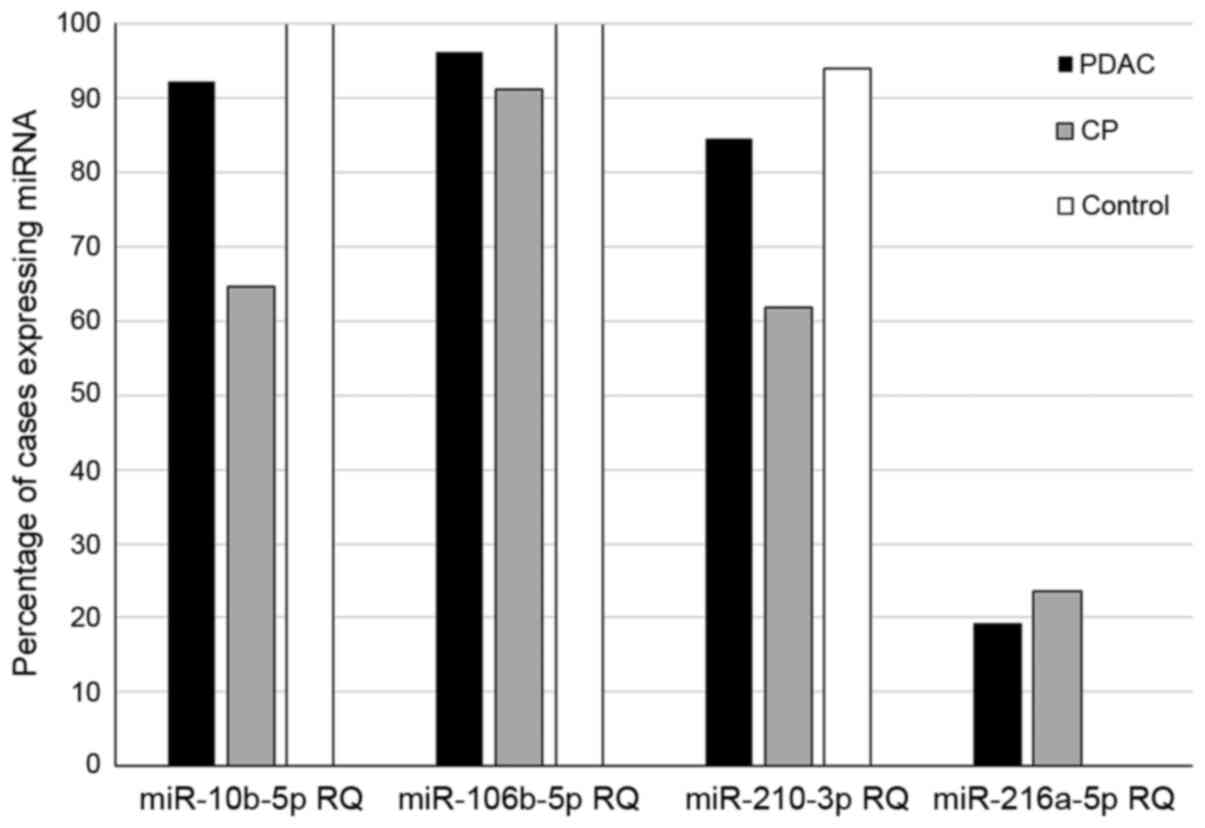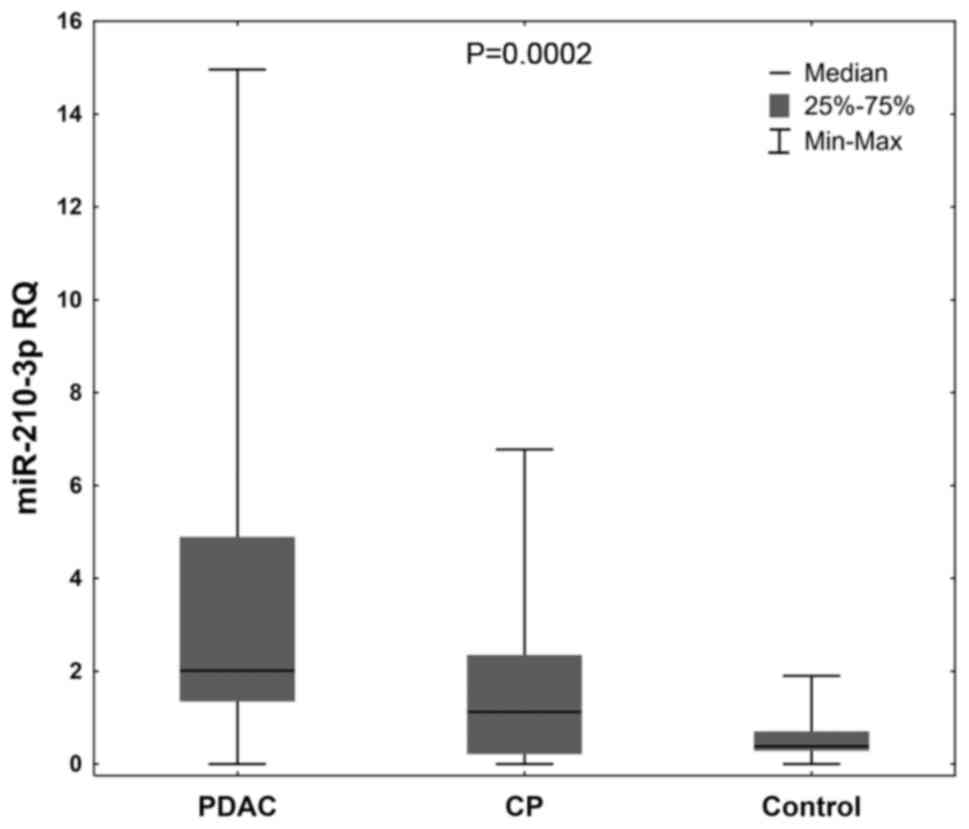|
1
|
Whitcomb DC, Frulloni L, Garg P, Greer JB,
Schneider A, Yadav D and Shimosegawa T: Chronic pancreatitis: An
international draft consensus proposal for a new mechanistic
definition. Pancreatology. 16:218–224. 2016.PubMed/NCBI View Article : Google Scholar
|
|
2
|
Ansari D, Tingstedt B, Andersson B,
Holmquist F, Sturesson C, Williamsson C, Sasor A, Borg D, Bauden M
and Andersson R: Pancreatic cancer: Yesterday, today and tomorrow.
Futur Oncol. 12:1929–1946. 2016.PubMed/NCBI View Article : Google Scholar
|
|
3
|
Raimondi S, Lowenfels AB, Morselli-Labate
AM, Maisonneuve P and Pezzilli R: Pancreatic cancer in chronic
pancreatitis; aetiology, incidence, and early detection. Best Pract
Res Clin Gastroenterol. 24:349–358. 2010.PubMed/NCBI View Article : Google Scholar
|
|
4
|
Wu DJ, Jiang YS, He RZ, Tao LY, Yang MW,
Fu XL, Yang JY and Zhu K: High expression of WNT7A predicts poor
prognosis and promote tumor metastasis in pancreatic ductal
adenocarcinoma. Sci Rep. 8(15792)2018.PubMed/NCBI View Article : Google Scholar
|
|
5
|
Siegel RL, Miller KD and Jemal A: Cancer
statistics, 2019. CA Cancer J Clin. 69:7–34. 2019.PubMed/NCBI View Article : Google Scholar
|
|
6
|
Becker AE, Hernandez YG, Frucht H and
Lucas AL: Pancreatic ductal adenocarcinoma: Risk factors,
screening, and early detection. World J Gastroenterol.
20:11182–11198. 2014.PubMed/NCBI View Article : Google Scholar
|
|
7
|
Ballehaninna UK and Chamberlain RS: The
clinical utility of serum CA 19-9 in the diagnosis, prognosis and
management of pancreatic adenocarcinoma: An evidence based
appraisal. J Gastrointest Oncol. 3:105–119. 2012.PubMed/NCBI View Article : Google Scholar
|
|
8
|
Duffy MJ, Sturgeon C, Lamerz R, Haglund C,
Holubec VL, Klapdor R, Nicolini A, Topolcan O and Heinemann V:
Tumor markers in pancreatic cancer: A European group on tumor
markers (EGTM) status report. Ann Oncol. 21:441–447.
2010.PubMed/NCBI View Article : Google Scholar
|
|
9
|
Halkova T, Cuperkova R, Minarik M and
Benesova L: MicroRNAs in pancreatic cancer: Involvement in
carcinogenesis and potential use for diagnosis and prognosis.
Gastroenterol Res Pract. 2015(892903)2015.PubMed/NCBI View Article : Google Scholar
|
|
10
|
Smith CD, Behrns KE, Van Heerden JA and
Sarr MG: Radical pancreatoduodenectomy for misdiagnosed pancreatic
mass. Br J Surg. 81:585–589. 1994.PubMed/NCBI View Article : Google Scholar
|
|
11
|
van Gulik TM, Reeders JW, Bosma A, Moojen
TM, Smits NJ, Allema JH, Rauws EA, Offerhaus GJ, Obertop H and
Gouma DJ: Incidence and clinical findings of benign, inflammatory
disease in patients resected for presumed pancreatic head cancer.
Gastrointest Endosc. 46:417–423. 1997.PubMed/NCBI View Article : Google Scholar
|
|
12
|
Nana-Sinkam SP, Fabbri M and Croce CM:
MicroRNAs in cancer: Personalizing diagnosis and therapy. Ann N Y
Acad Sci. 1210:25–33. 2010.PubMed/NCBI View Article : Google Scholar
|
|
13
|
Sheedy P and Medarova Z: The fundamental
role of miR-10b in metastatic cancer. Am J Cancer Res. 8:1674–1688.
2018.PubMed/NCBI
|
|
14
|
Yonemori K, Seki N, Idichi T, Kurahara H,
Osako Y, Koshizuka K, Arai T, Okato A, Kita Y, Arigami T, et al:
The microRNA expression signature of pancreatic ductal
adenocarcinoma by RNA sequencing: Anti-tumour functions of the
microRNA-216 cluster. Oncotarget. 8:70097–70115. 2017.PubMed/NCBI View Article : Google Scholar
|
|
15
|
Ding L, Zhao L, Chen W, Liu T, Li Z and Li
X: miR-210, a modulator of hypoxia-induced epithelial-mesenchymal
transition in ovarian cancer cell. Int J Clin Exp Med. 8:2299–2307.
2015.PubMed/NCBI
|
|
16
|
Dang K and Myers KA: The role of
hypoxia-induced miR-210 in cancer progression. Int J Mol Sci.
16:6353–6372. 2015.PubMed/NCBI View Article : Google Scholar
|
|
17
|
Kaur S, Krishn SR, Rachagani S and Batra
SK: Significance of microRNA-based biomarkers for pancreatic
cancer. Ann Transl Med. 3(277)2015.PubMed/NCBI View Article : Google Scholar
|
|
18
|
World Medical Association. Declaration of
Helsinki world medical association declaration of Helsinki. Ethical
principles for medical research involving human subjects. Bull
World Health Organ. 79:373–374. 2001.PubMed/NCBI
|
|
19
|
Gebert LFR and MacRae IJ: Regulation of
microRNA function in animals. Nat Rev Mol Cell Biol. 20:21–37.
2019.PubMed/NCBI View Article : Google Scholar
|
|
20
|
Raisch J, Darfeuille-Michaud A and Nguyen
HT: Role of microRNAs in the immune system, inflammation and
cancer. World J Gastroenterol. 19:2985–2996. 2013.PubMed/NCBI View Article : Google Scholar
|
|
21
|
Li Y and Sarkar FH: MicroRNA targeted
therapeutic approach for pancreatic cancer. Int J Biol Sci.
12:326–337. 2016.PubMed/NCBI View Article : Google Scholar
|
|
22
|
Vila-Casadesús M, Vila-Navarro E, Raimondi
G, Fillat C, Castells A, Lozano JJ and Gironella M: Deciphering
microRNA targets in pancreatic cancer using miRComb R package.
Oncotarget. 9:6499–6517. 2018.PubMed/NCBI View Article : Google Scholar
|
|
23
|
Vogel A, Kullmann F, Kunzmann V, Al-Batran
SE, Oettle H, Plentz R, Siveke J, Springfeld C and Riess H:
Patients with advanced pancreatic cancer and hyperbilirubinaemia:
Review and German expert opinion on treatment with nab-paclitaxel
plus gemcitabine. Oncol Res Treat. 38:596–603. 2015.PubMed/NCBI View Article : Google Scholar
|
|
24
|
Ouyang H, Gore J, Deitz S and Korc M:
microRNA-10b enhances pancreatic cancer cell invasion by
suppressing TIP30 expression and promoting EGF and TGF-β actions.
Oncogene. 33:4664–4674. 2014.PubMed/NCBI View Article : Google Scholar
|
|
25
|
Melisi D, Garcia-Carbonero R, Macarulla T,
Pezet D, Deplanque G, Fuchs M, Trojan J, Kozloff M, Simionato F,
Cleverly A, et al: TGFβ receptor inhibitor galunisertib is linked
to inflammation- and remodeling-related proteins in patients with
pancreatic cancer. Cancer Chemother Pharmacol. 83:975–991.
2019.PubMed/NCBI View Article : Google Scholar
|
|
26
|
Melisi D, Garcia-Carbonero R, Macarulla T,
Pezet D, Deplanque G, Fuchs M, Trojan J, Oettle H, Kozloff M,
Cleverly A, et al: Galunisertib plus gemcitabine vs. gemcitabine
for first-line treatment of patients with unresectable pancreatic
cancer. Br J Cancer. 119:1208–1214. 2018.PubMed/NCBI View Article : Google Scholar
|
|
27
|
Wang J, Raimondo M, Guha S, Chen J, Diao
L, Dong X, Wallace MB, Killary AM, Frazier ML, Woodward TA, et al:
Circulating microRNAs in pancreatic juice as candidate biomarkers
of pancreatic cancer. J Cancer. 5:696–705. 2014.PubMed/NCBI View Article : Google Scholar
|
|
28
|
Ho AS, Huang X, Cao H, Christman-Skieller
C, Bennewith K, Le QT and Koong AC: Circulating miR-210 as a novel
hypoxia marker in pancreatic cancer. Transl Oncol. 3:109–113.
2010.PubMed/NCBI View Article : Google Scholar
|
|
29
|
Calatayud D, Dehlendorff C, Boisen MK,
Hasselby JP, Schultz NA, Werner J, Immervoll H, Molven A, Hansen CP
and Johansen JS: Tissue MicroRNA profiles as diagnostic and
prognostic biomarkers in patients with resectable pancreatic ductal
adenocarcinoma and periampullary cancers. Biomark Res.
5(8)2017.PubMed/NCBI View Article : Google Scholar
|
|
30
|
Cheng HH, Mitchell PS, Kroh EM, Dowell AE,
Chéry L, Siddiqui J, Nelson PS, Vessella RL, Knudsen BS, Chinnaiyan
AM, et al: Circulating microRNA profiling identifies a subset of
metastatic prostate cancer patients with evidence of
cancer-associated hypoxia. PLoS One. 8(e69239)2013.PubMed/NCBI View Article : Google Scholar
|
|
31
|
Irlam-Jones JJ, Eustace A, Denley H,
Choudhury A, Harris AL, Hoskin PJ and West CL: Expression of
miR-210 in relation to other measures of hypoxia and prediction of
benefit from hypoxia modification in patients with bladder cancer.
Br J Cancer. 115:571–578. 2016.PubMed/NCBI View Article : Google Scholar
|
|
32
|
Zhang H, Mai Q and Chen J: MicroRNA-210 is
increased and it is required for dedifferentiation of osteosarcoma
cell line. Cell Biol Int. 41:267–275. 2017.PubMed/NCBI View Article : Google Scholar
|
|
33
|
Foekens JA, Sieuwerts AM, Smid M, Look MP,
de Weerd V, Boersma AW, Klijn JG, Wiemer EA and Martens JW: Four
miRNAs associated with aggressiveness of lymph node-negative,
estrogen receptor-positive human breast cancer. Proc Natl Acad Sci
USA. 105:13021–13026. 2008.PubMed/NCBI View Article : Google Scholar
|
|
34
|
Koong AC, Mehta VK, Le QT, Fisher GA,
Terris DJ, Brown JM, Bastidas AJ and Vierra M: Pancreatic tumors
show high levels of hypoxia. Int J Radiat Oncol Biol Phys.
48:919–922. 2000.PubMed/NCBI View Article : Google Scholar
|
|
35
|
Yan Y, Wang C, Zhou W, Shi Y, Guo P, Liu
Y, Wang J, Zhang CY and Zhang C: Elevation of circulating
miR-210-3p in high-altitude hypoxic environment. Front Physiol.
7(84)2016.PubMed/NCBI View Article : Google Scholar
|
|
36
|
Crosby ME, Kulshreshtha R, Ivan M and
Glazer PM: MicroRNA regulation of DNA repair gene expression in
hypoxic stress. Cancer Res. 69:1221–1229. 2009.PubMed/NCBI View Article : Google Scholar
|
|
37
|
Mizuno Y, Tokuzawa Y, Ninomiya Y, Yagi K,
Yatsuka-Kanesaki Y, Suda T, Fukuda T, Katagiri T, Kondoh Y, Amemiya
T, et al: miR-210 promotes osteoblastic differentiation through
inhibition of AcvR1b. FEBS Lett. 583:2263–2268. 2009.PubMed/NCBI View Article : Google Scholar
|
|
38
|
Chen Z, Li Y, Zhang H, Huang P and Luthra
R: Hypoxia-regulated microRNA-210 modulates mitochondrial function
and decreases ISCU and COX10 expression. Oncogene. 29:4362–4368.
2010.PubMed/NCBI View Article : Google Scholar
|
|
39
|
Masamune A, Kikuta K, Watanabe T, Satoh K,
Hirota M and Shimosegawa T: Hypoxia stimulates pancreatic stellate
cells to induce fibrosis and angiogenesis in pancreatic cancer. Am
J Physiol Gastrointest Liver Physiol. 295:G709–G717.
2008.PubMed/NCBI View Article : Google Scholar
|
|
40
|
Friess H, Yamanaka Y, Büchler M, Beger HG,
Do DA, Kobrin MS and Korc M: Increased expression of acidic and
basic fibroblast growth factors in chronic pancreatitis. Am J
Pathol. 144:117–128. 1994.PubMed/NCBI
|
|
41
|
Kobrin MS, Yamanaka Y, Friess H, Lopez ME
and Korc M: Aberrant expression of type I fibroblast growth factor
receptor in human pancreatic adenocarcinomas. Cancer Res.
53:4741–4744. 1993.PubMed/NCBI
|
|
42
|
Yamanaka Y, Friess H, Buchler M, Beger HG,
Uchida E, Onda M, Kobrin MS and Korc M: Overexpression of acidic
and basic fibroblast growth factors in human pancreatic cancer
correlates with advanced tumor stage. Cancer Res. 53:5289–5296.
1993.PubMed/NCBI
|
|
43
|
Kuehn R, Lelkes PI, Bloechle C, Niendorf A
and Izbicki JR: Angiogenesis, angiogenic growth factors, and cell
adhesion molecules are upregulated in chronic pancreatic diseases:
Angiogenesis in chronic pancreatitis and in pancreatic cancer.
Pancreas. 18:96–103. 1999.PubMed/NCBI View Article : Google Scholar
|
















